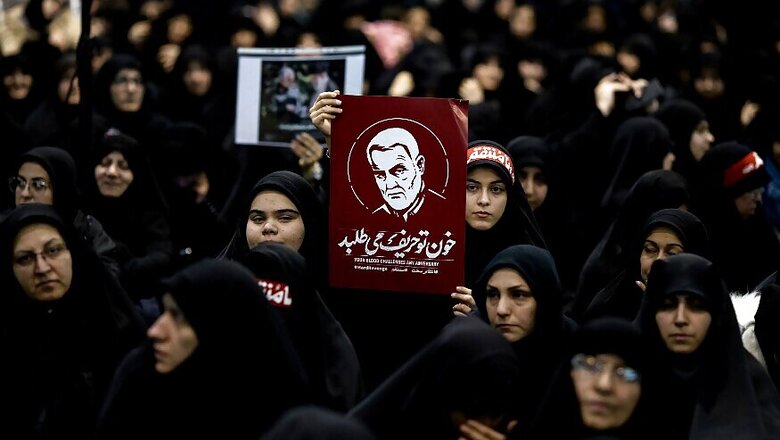
views
After pulling back from the brink of war, leaders in the United States and Iran may well be evaluating what they have gained and what they have lost in a conflict that has been waged for 20 months.
Looking to de-escalate and mindful of political pressures at home, both sides are publicly declaring victory. But objective assessments might not be sunny, analysts say.
Since President Donald Trump withdrew from the Iran nuclear accord and imposed crushing sanctions on Iran’s economy in May 2018, kicking off a cycle of tit-for-tat escalation, both countries have suffered consequential losses in each major issue at stake in their rivalry.
And while each has also made gains, they have been modest in comparison, analysts say. Ostensible victories have mostly had the effect of harming the other side without bringing clear and concrete gains.
The result has been a clear “lose-lose,” said Dalia Dassa Kaye, who directs a Middle East policy center at RAND Corp., a nonpartisan research group.
While the conflict appears far from over and its ramifications could take months or years to unfold, so far, she said, “The tally is looking bad for both sides.”
The United States has seen more setbacks than advances in its ambitions to increase limits on Iran’s nuclear program, end Iran’s use of armed proxies and, most sweeping of all, remake the Middle Eastern power balance to Iran’s detriment.
Iran fared little better with its goals of securing influence in the region, as well as salvaging the international diplomatic opening and the relief from economic sanctions that the nuclear deal had granted it until Trump withdrew.
The nearly two-year episode is a lesson in the limits of zero-sum theories of conflict, which holds that one adversary’s loss is invariably the other’s gain. In this case, an accounting of the major gains and losses on each side, compiled below, suggests that at nearly every turn, escalations by the United States and Iran have ultimately left each side worse off.
THE STRUGGLE FOR THE MIDDLE EAST
Much of the conflict has played out amid U.S. efforts to curtail Iran’s use of proxy forces and to turn back the country’s growing regional influence.
Concrete American gains in this area are difficult to identify.
US actions have not yet altered Iran’s use of proxy forces or persuaded it to step back from the wider region. Rather, Iranian proxy activity has increased. The threats may have hardened Tehran’s belief that its fight with the United States is existential, compelling it to fight all the harder.
And despite the staggering significance of Washington’s decision to kill Gen. Qassem Soleimani, Iran’s top military leader, this has yet to demonstrably change Iranian behaviour or the regional power balance.
“Assassinations on their own do not remove long-term strategic and political threats or dilemmas,” Dahlia Scheindlin, an Israeli analyst, wrote in a policy brief for the Century Foundation, a think tank.
“There is no substitute for a political solution,” she said.
American losses in the region, on the other hand, have been clearer.
Killing Soleimani on Iraqi soil led Iraq’s parliament to pass a bill demanding that US troops leave the country. While it remains unclear whether the Americans will ultimately leave, Washington’s relationship with the country seems grievously damaged.
The turmoil has also left US-led efforts against the Islamic State militant group in doubt.
And Persian Gulf allies such as Saudi Arabia, apparently fearful of being pulled into a wider conflict, have sought to de-escalate with Tehran. This has left the United States with fewer partners in isolating Iranian influence.
Iranian gains in the region, however likely, remain mostly theoretical.
Tehran could ultimately fill the void left by any US withdrawal or diplomatic rift between Washington and Baghdad, but that has not yet happened.
Street-level Iraqi anger at Iranian influence was already high before the recent weeks of conflict. And Iran’s retaliation for the killing of Soleimani — firing missiles at military bases in Iraq that housed U.S. soldiers — was hardly a show of respect for Iraqi sovereignty.
Soleimani’s death led to an outpouring of nationalist sentiment within Iran. Still, with Iran’s economy in shambles, this will probably prove temporary, Kaye said. “The domestic pressures and potential for unrest remain,” she said.
Iranian losses center on the death of Soleimani, who was a major figure in Iran’s campaigns to reshape Middle Eastern conflicts and politics in its favor.
While his killing “will certainly damage some of his key projects,” Scheindlin wrote, there is little reason to believe that Iran will change its behavior. The country’s vast military and intelligence services are considered too large and sophisticated for one person’s death to bring drastic policy change.
All told, the broad contours of Middle Eastern power politics appear to be holding. The United States and Iran have both been somewhat weakened, and neither has come obviously nearer to its major goals.
THE NUCLEAR ISSUE
Trump withdrew from the 2015 nuclear accord on claims — contradicted by international inspectors and by his own military and intelligence leaders — that Iran was seeking to acquire a nuclear weapon. He pledged to stop this and to impose tighter restrictions than those in the initial agreement.
Since then, Iran’s focus has been on reinstating the economic and diplomatic relief that the 2015 agreement was supposed to offer.
American gains on the nuclear issue have not yet materialized. Iran remains no closer to submitting to nuclear restrictions beyond those in the 2015 accord.
But American losses have been growing.
Iran has at times responded to US escalations by announcing it will no longer comply with certain nuclear restrictions. While Iran has so far taken few actual steps toward greater nuclear development, it will face weaker limitations should it ever choose to do so.
The international coalition that negotiated the agreement with Iran, and was meant to police it, has fragmented, leaving Washington to seek and enforce a new status quo all on its own — something that took the combined work of the world’s major powers last time around.
And Trump’s decision to withdraw from the accord could leave Tehran and other US adversaries skeptical of making nuclear concessions in the future.
“It’s just not clear what credibility the US has to make a nonproliferation agreement with an enemy anymore,” said Elizabeth N. Saunders, a Georgetown University political scientist. She asked, “Would anyone ever enter a deal like the Iran deal with us ever again?”
Still, Iranian gains are more modest than they might seem.
It’s true that Iran has exploited international outrage at U.S. brinkmanship to withdraw from some nuclear restrictions without provoking a crisis.
But Tehran’s statements and actions strongly suggest that its primary goal is not acquiring a nuclear weapon but rather reinstating the economic and diplomatic benefits afforded by the deal. While Iran may have hoped that turning up the pressure would push the international community to bring this about, it has not come any obviously closer to that goal.
Iranian losses appear larger. Its economy has suffered under sanctions, exacerbating domestic unrest.
And Iranian threats and proxy attacks have alienated it from the European powers it had hoped might pressure the Americans to back down. A French-led effort last fall to hand Iran $15 billion in credit, in exchange for the country returning to the terms of the nuclear agreement, collapsed under US opposition.
“I’m not sure how much international sympathy it really has,” Kaye said of Iran, “though the US has alienated a lot of international partners too, so that may be a wash.”
Both the United States and Iran are left, as a result, much further from the aspects of the 2015 nuclear agreement that appealed to each of them.
Instead, they are barrelling toward a scenario that would combine each side’s worst nightmares: severe sanctions and international isolation for Iran, but weak or non-existent restraints on its nuclear program.
That risk underscores that months of conflict have, across every major issue, raised the stakes for both sides, all while making it harder for either to back down.
“All the conditions that got us to this point are still in place, and now we’re facing the new reality that the US and Iran have engaged in direct and open conflict,” Kaye said.
She takes a skeptical view of the declarations of victory coming from Washington and Tehran.
“This is not the time for victory laps,” she said.
Max Fisher c.2020 The New York Times Company




















Comments
0 comment